A High Precision Artificial Neural Networks Model for Short-Term Energy Load Forecasting
Abstract
1. Introduction
2. Methodology of Artificial Neural Networks
3. The Proposed Deep Neural Network
4. Experimental Results
5. Discussion
6. Conclusions
Acknowledgments
Author Contributions
Conflicts of Interest
References
- Raza, M.Q.; Khosravi, A. A review on artificial intelligence based load demand forecasting techniques for smart grid and buildings. Renew. Sustain. Energy Rev. 2015, 50, 1352–1372. [Google Scholar] [CrossRef]
- Da Graça Carvalho, M.; Bonifacio, M.; Dechamps, P. Building a low carbon society. Energy 2011, 36, 1842–1847. [Google Scholar] [CrossRef]
- Jiang, B.; Sun, Z.; Liu, M. China’s energy development strategy under the low-carbon economy. Energy 2010, 35, 4257–4264. [Google Scholar] [CrossRef]
- Cho, H.; Goude, Y.; Brossat, X.; Yao, Q. Modeling and forecasting daily electricity load curves: A hybrid approach. J. Am. Stat. Assoc. 2013, 108, 7–21. [Google Scholar] [CrossRef]
- Javed, F.; Arshad, N.; Wallin, F.; Vassileva, I.; Dahlquist, E. Forecasting for demand response in smart grids: An analysis on use of anthropologic and structural data and short term multiple loads forecasting. Appl. Energy 2012, 96, 150–160. [Google Scholar] [CrossRef]
- Iwafune, Y.; Yagita, Y.; Ikegami, T.; Ogimoto, K. Short-term forecasting of residential building load for distributed energy management. In Proceedings of the 2014 IEEE International Energy Conference, Cavtat, Croatia, 13–16 May 2014; pp. 1197–1204. [Google Scholar] [CrossRef]
- Short Term Electricity Load Forecasting on Varying Levels of Aggregation. Available online: https://arxiv.org/abs/1404.0058v3 (accessed on 11 January 2018).
- Gerwig, C. Short term load forecasting for residential buildings—An extensive literature review. Smart Innov. Syst. 2015, 39, 181–193. [Google Scholar]
- Hippert, H.S.; Pedreira, C.E.; Souza, R.C. Neural networks for short-term load forecasting: A review and evaluation. IEEE Trans. Power Syst. 2001, 16, 44–55. [Google Scholar] [CrossRef]
- Metaxiotis, K.; Kagiannas, A.; Askounis, D.; Psarras, J. Artificial intelligence in short term electric load forecasting: A state-of-the-art survey for the researcher. Energy Convers. Manag. 2003, 44, 1524–1534. [Google Scholar] [CrossRef]
- Tzafestas, S.; Tzafestas, E. Computational intelligence techniques for short-term electric load forecasting. J. Intell. Robot. Syst. 2001, 31, 7–68. [Google Scholar] [CrossRef]
- Ghayekhloo, M.; Menhaj, M.B.; Ghofrani, M. A hybrid short-term load forecasting with a new data preprocessing framework. Electr. Power Syst. Res. 2015, 119, 138–148. [Google Scholar] [CrossRef]
- Xia, C.; Wang, J.; McMenemy, K. Short, medium and long term load forecasting model and virtual load forecaster based on radial basis function neural networks. Int. J. Electr. Power Energy Syst. 2010, 32, 743–750. [Google Scholar] [CrossRef]
- Bughin, J.; Hazan, E.; Ramaswamy, S.; Chui, M. Artificial Intelligence—The Next Digital Frontier? Mckinsey Global Institute: New York, NY, USA, 2017; pp. 1–80. [Google Scholar]
- Oh, C.; Lee, T.; Kim, Y.; Park, S.; Kwon, S.B.; Suh, B. Us vs. Them: Understanding Artificial Intelligence Technophobia over the Google DeepMind Challenge Match. In Proceedings of the 2017 CHI Conference on Human Factors in Computing Systems, Denver, CO, USA, 6–11 May 2017; pp. 2523–2534. [Google Scholar] [CrossRef]
- Skilton, M.; Hovsepian, F. Example Case Studies of Impact of Artificial Intelligence on Jobs and Productivity. In 4th Industrial Revolution; National Academies Press: Washingtom, DC, USA, 2018; pp. 269–291. [Google Scholar]
- Ekonomou, L.; Christodoulou, C.A.; Mladenov, V. A short-term load forecasting method using artificial neural networks and wavelet analysis. Int. J. Power Syst. 2016, 1, 64–68. [Google Scholar]
- Valgaev, O.; Kupzog, F. Low-Voltage Power Demand Forecasting Using K-Nearest Neighbors Approach. In Proceedings of the Innovative Smart Grid Technologies—Asia (ISGT-Asia), Melbourne, VIC, Australia, 28 November–1 December 2016. [Google Scholar]
- Valgaev, O.; Kupzog, F. Building Power Demand Forecasting Using K-Nearest Neighbors Model—Initial Approach. In Proceedings of the IEEE PES Asia-Pacific Power Energy Conference, Xi’an, China, 25–28 October 2016; pp. 1055–1060. [Google Scholar]
- Humeau, S.; Wijaya, T.K.; Vasirani, M.; Aberer, K. Electricity load forecasting for residential customers: Exploiting aggregation and correlation between households. In Proceedings of the 2013 Sustainable Internet and ICT for Sustainability, Palermo, Italy, 30–31 October 2013. [Google Scholar]
- Veit, A.; Goebel, C.; Tidke, R.; Doblander, C.; Jacobsen, H. Household electricity demand forecasting: Benchmarking state-of-the-art method. In Proceedings of the 5th International Confrerence Future Energy Systems, Cambridge, UK, 11–13 June 2014; pp. 233–234. [Google Scholar] [CrossRef]
- Jetcheva, J.G.; Majidpour, M.; Chen, W. Neural network model ensembles for building-level electricity load forecasts. Energy Build. 2014, 84, 214–223. [Google Scholar] [CrossRef]
- Kardakos, E.G.; Alexiadis, M.C.; Vagropoulos, S.I.; Simoglou, C.K.; Biskas, P.N.; Bakirtzis, A.G. Application of time series and artificial neural network models in short-term forecasting of PV power generation. In Proceedings of the 2013 48th International Universities’ Power Engineering Conference, Dublin, Ireland, 2–5 September 2013; pp. 1–6. [Google Scholar] [CrossRef]
- Fujimoto, Y.; Hayashi, Y. Pattern sequence-based energy demand forecast using photovoltaic energy records. In Proceedings of the 2012 International Conference on Renewable Energy Research and Applications, Nagasaki, Japan, 11–14 November 2012. [Google Scholar]
- Chaouch, M. Clustering-based improvement of nonparametric functional time series forecasting: Application to intra-day household-level load curves. IEEE Trans. Smart Grid 2014, 5, 411–419. [Google Scholar] [CrossRef]
- Niu, D.; Dai, S. A short-term load forecasting model with a modified particle swarm optimization algorithm and least squares support vector machine based on the denoising method of empirical mode decomposition and grey relational analysis. Energies 2017, 10, 408. [Google Scholar] [CrossRef]
- Deo, R.C.; Wen, X.; Qi, F. A wavelet-coupled support vector machine model for forecasting global incident solar radiation using limited meteorological dataset. Appl. Energy 2016, 168, 568–593. [Google Scholar] [CrossRef]
- Soubdhan, T.; Ndong, J.; Ould-Baba, H.; Do, M.T. A robust forecasting framework based on the Kalman filtering approach with a twofold parameter tuning procedure: Application to solar and photovoltaic prediction. Sol. Energy 2016, 131, 246–259. [Google Scholar] [CrossRef]
- Hahn, H.; Meyer-Nieberg, S.; Pickl, S. Electric load forecasting methods: Tools for decision making. Eur. J. Oper. Res. 2009, 199, 902–907. [Google Scholar] [CrossRef]
- Zhang, G.; Patuwo, B.E.; Hu, M.Y. Forecasting with artificial neural networks: The state of the art. Int. J. Forecast. 1998, 14, 35–62. [Google Scholar] [CrossRef]
- Pappas, S.S.; Ekonomou, L.; Moussas, V.C.; Karampelas, P.; Katsikas, S.K. Adaptive load forecasting of the Hellenic electric grid. J. Zhejiang Univ. A 2008, 9, 1724–1730. [Google Scholar] [CrossRef]
- White, B.W.; Rosenblatt, F. Principles of neurodynamics: Perceptrons and the theory of brain mechanisms. Am. J. Psychol. 1963, 76, 705. [Google Scholar] [CrossRef]
- Hochreiter, S.; Urgen Schmidhuber, J. Long short-term memory. Neural Comput. 1997, 9, 1735–1780. [Google Scholar] [CrossRef] [PubMed]
- Srivastava, N.; Hinton, G.; Krizhevsky, A.; Sutskever, I.; Salakhutdinov, R. Dropout: A Simple Way to Prevent Neural Networks from Overfitting. J. Mach. Learn. Res. 2014, 15, 1929–1958. [Google Scholar] [CrossRef]
- Suykens, J.A.K.; Vandewalle, J. Least squares support vector machine classifiers. Neural Process. Lett. 1999, 9, 293–300. [Google Scholar] [CrossRef]
- Liaw, A.; Wiener, M. Classification and Regression by randomForest. R News 2002, 2, 18–22. [Google Scholar] [CrossRef]
- Safavian, S.R.; Landgrebe, D. A Survey of Decision Tree Classifier Methodology. IEEE Trans. Syst. Man Cybern. 1991, 21, 660–674. [Google Scholar] [CrossRef]
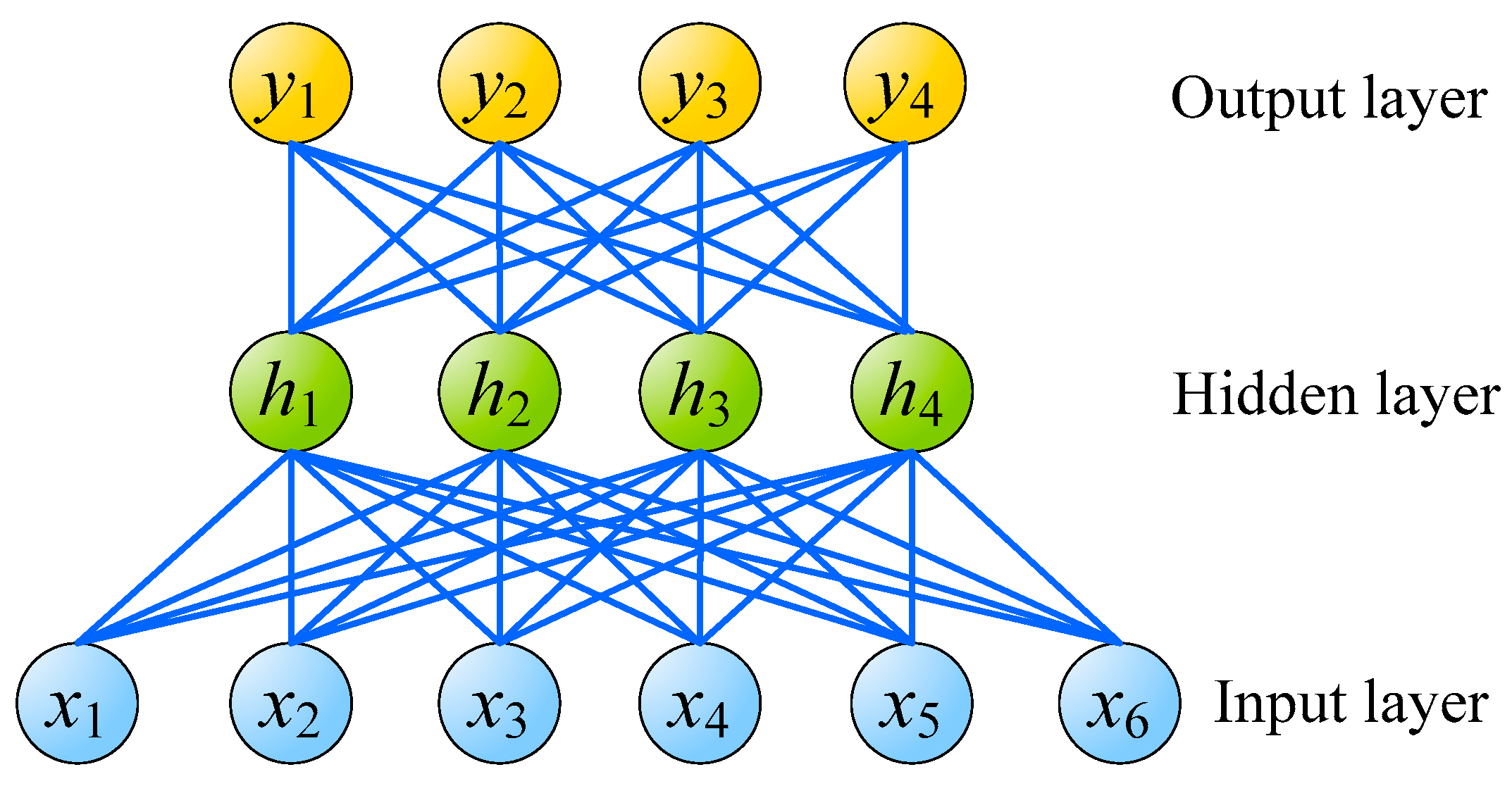
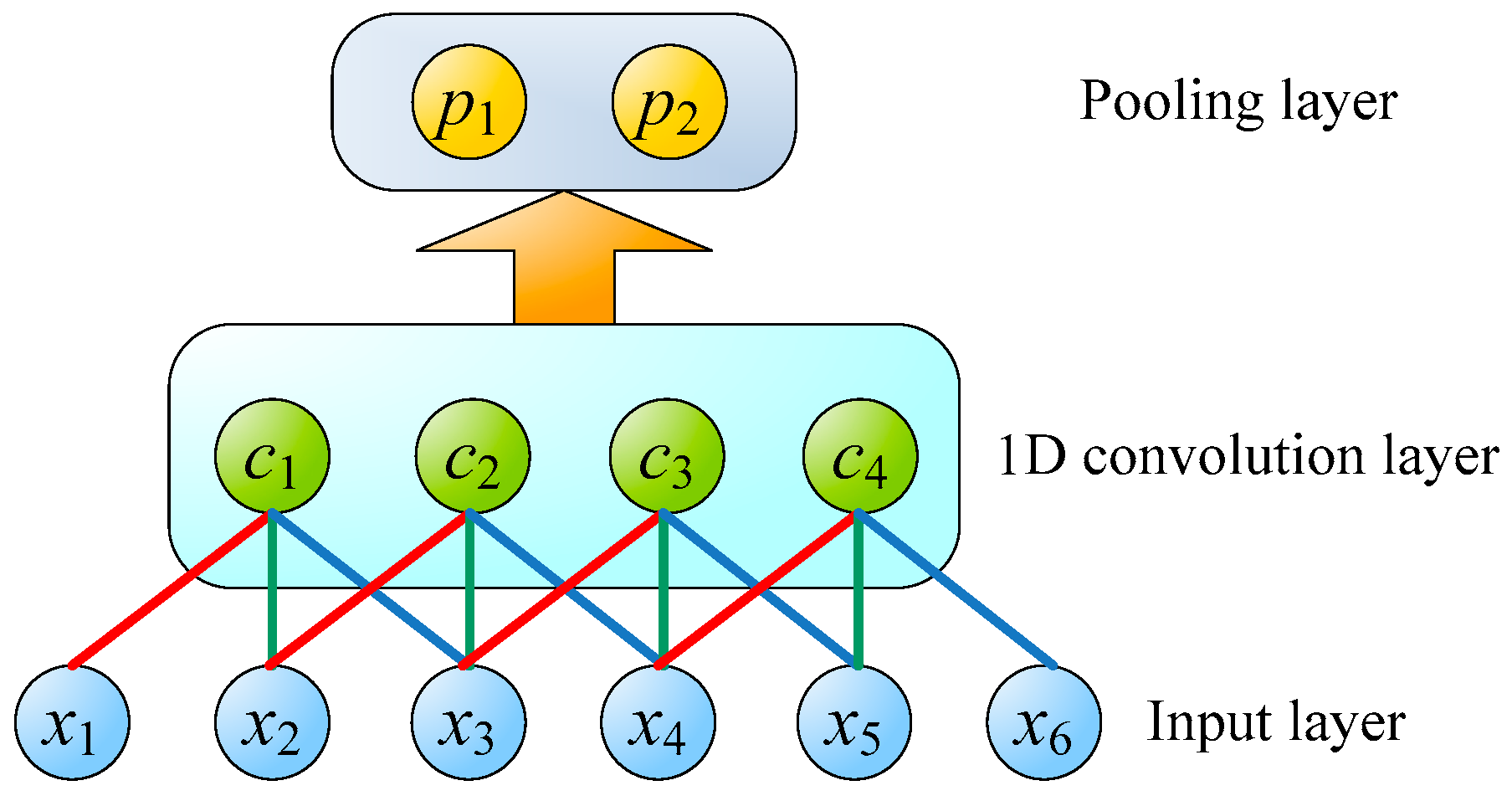
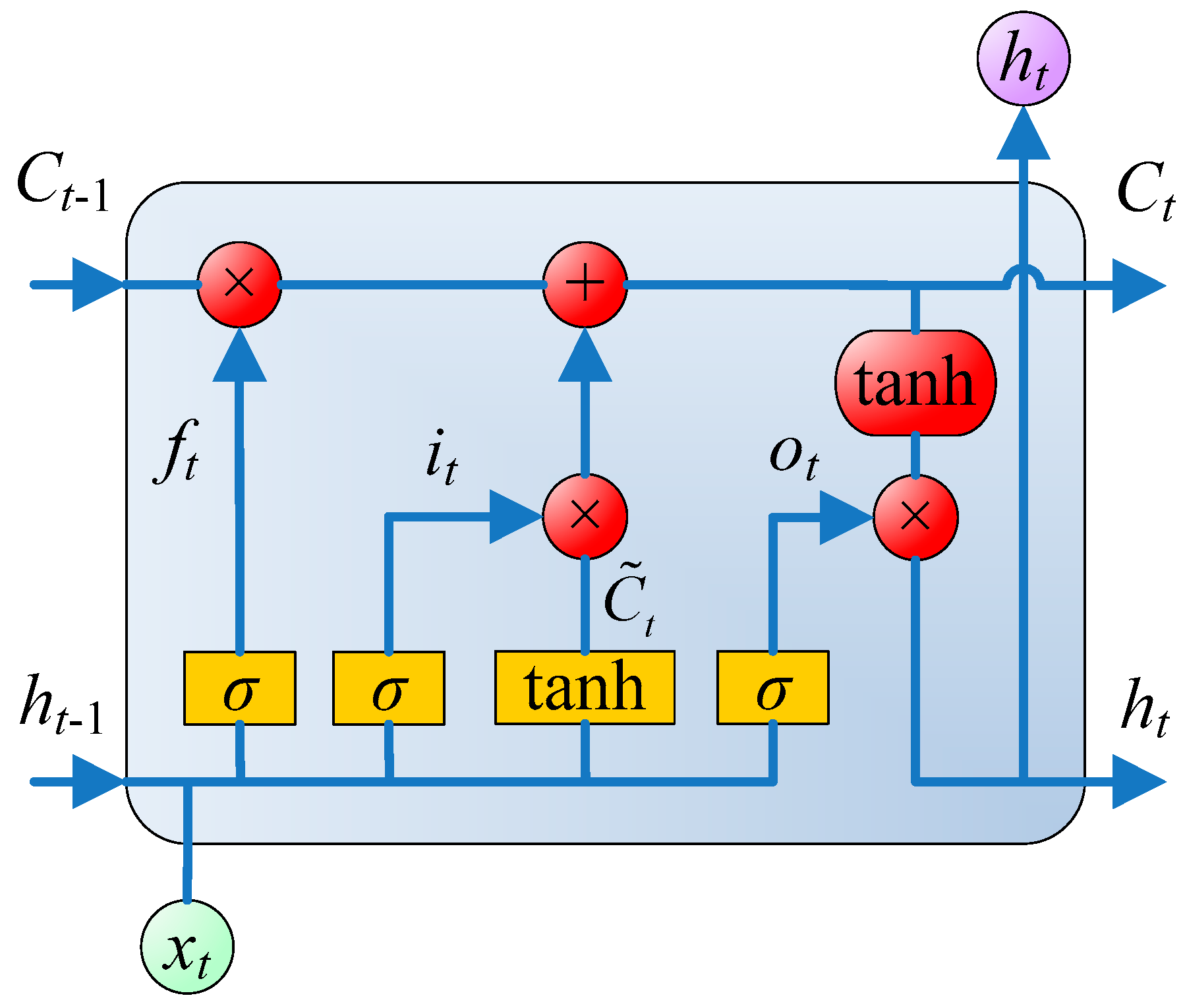
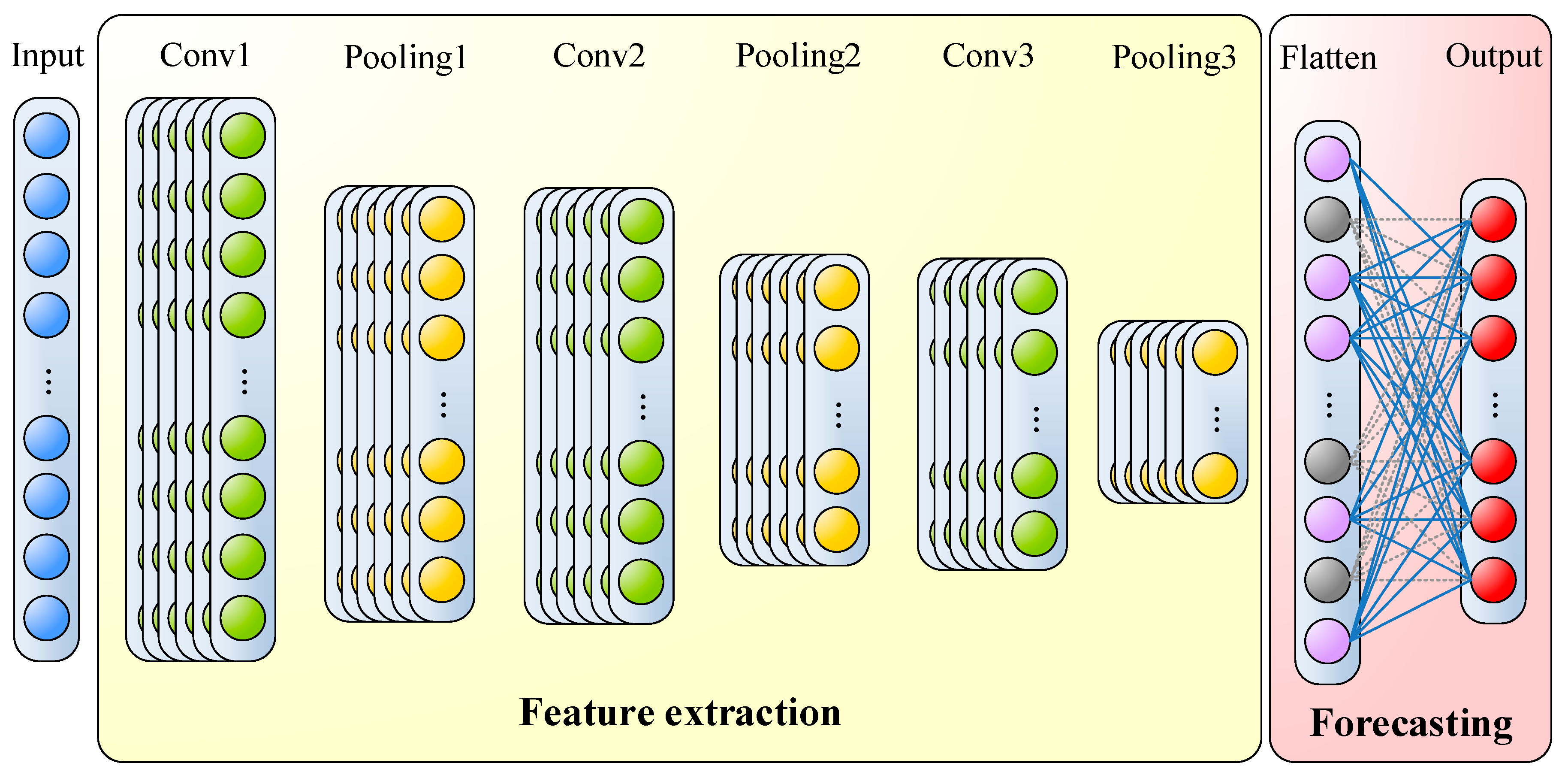
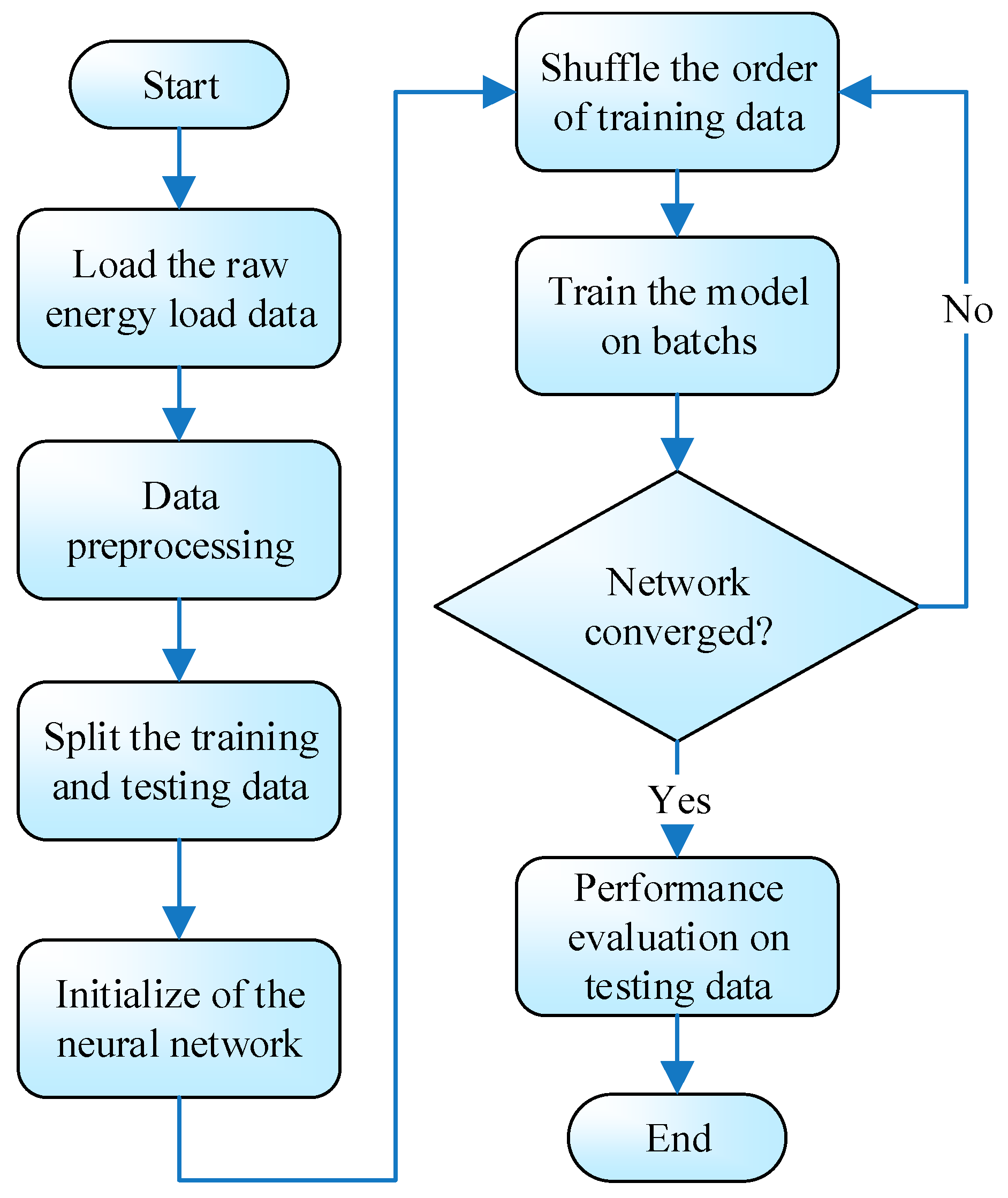
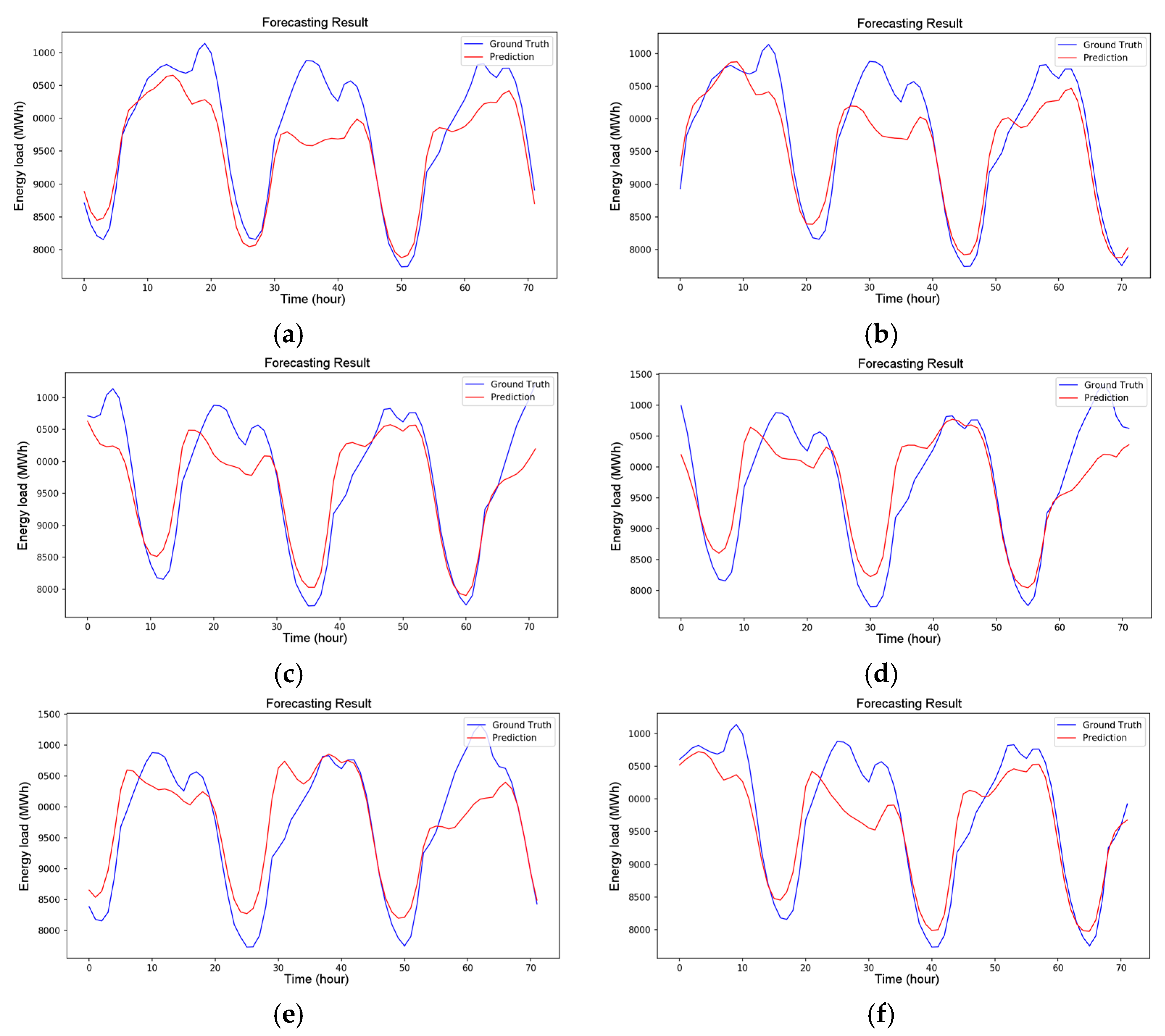
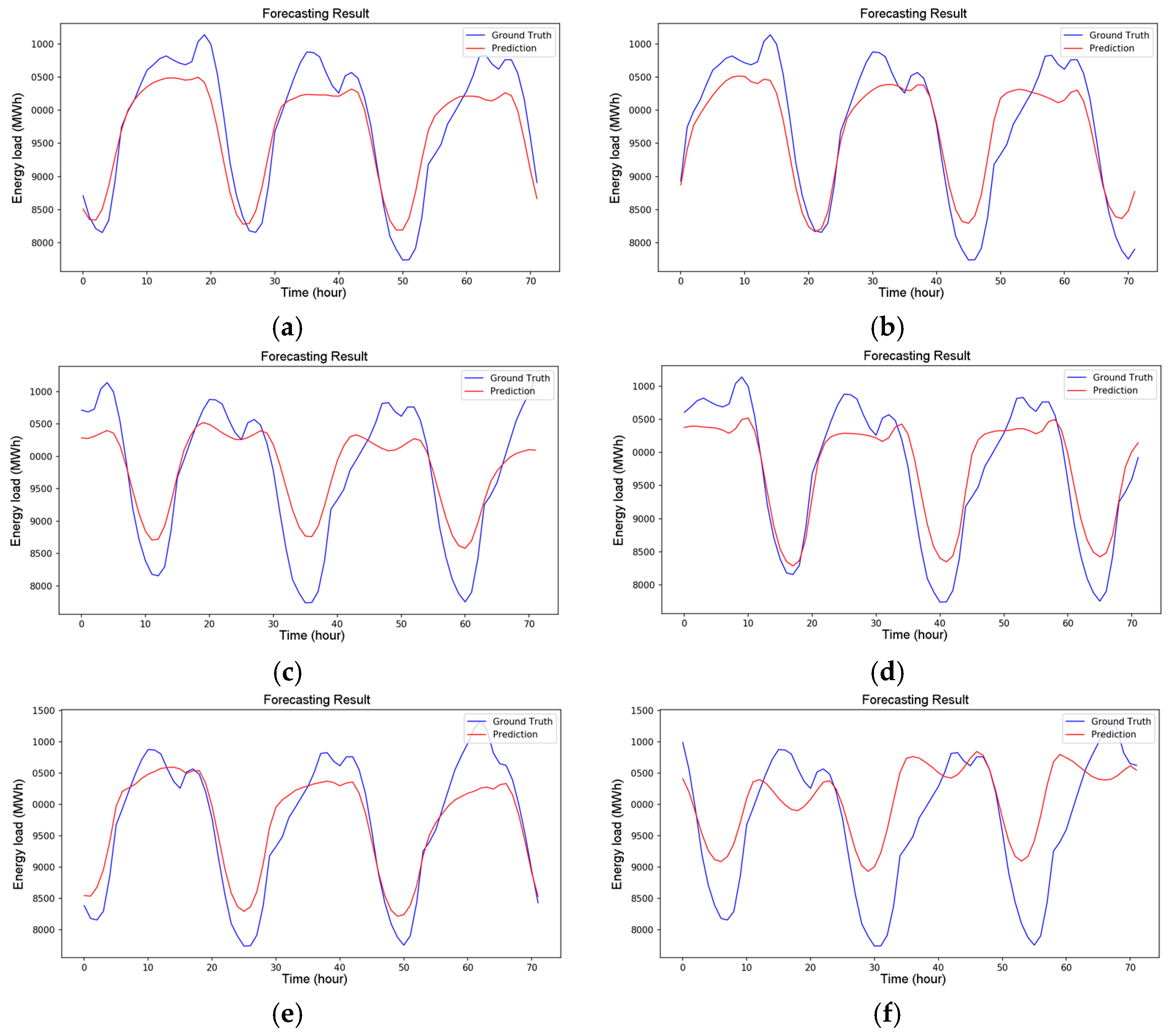
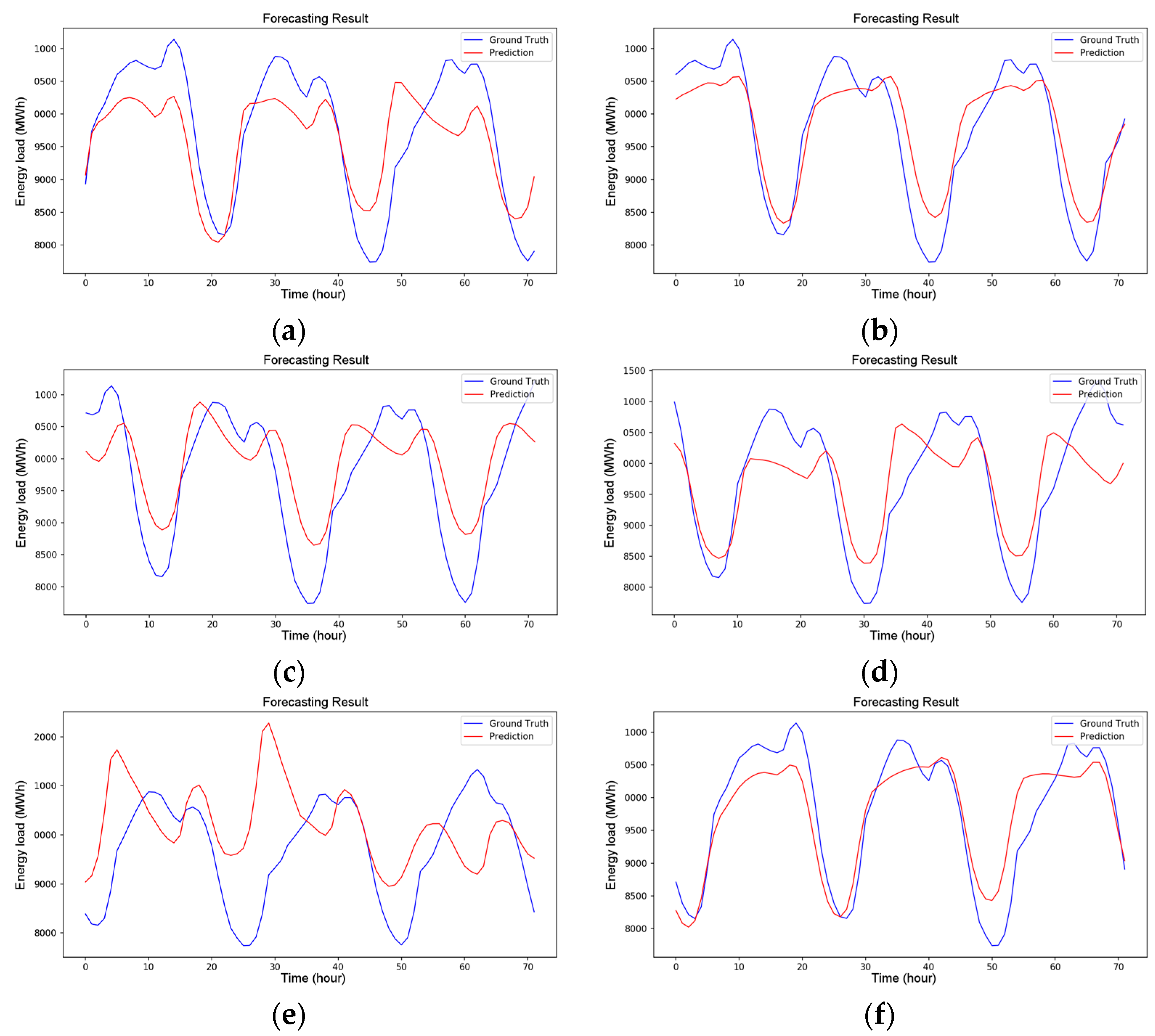
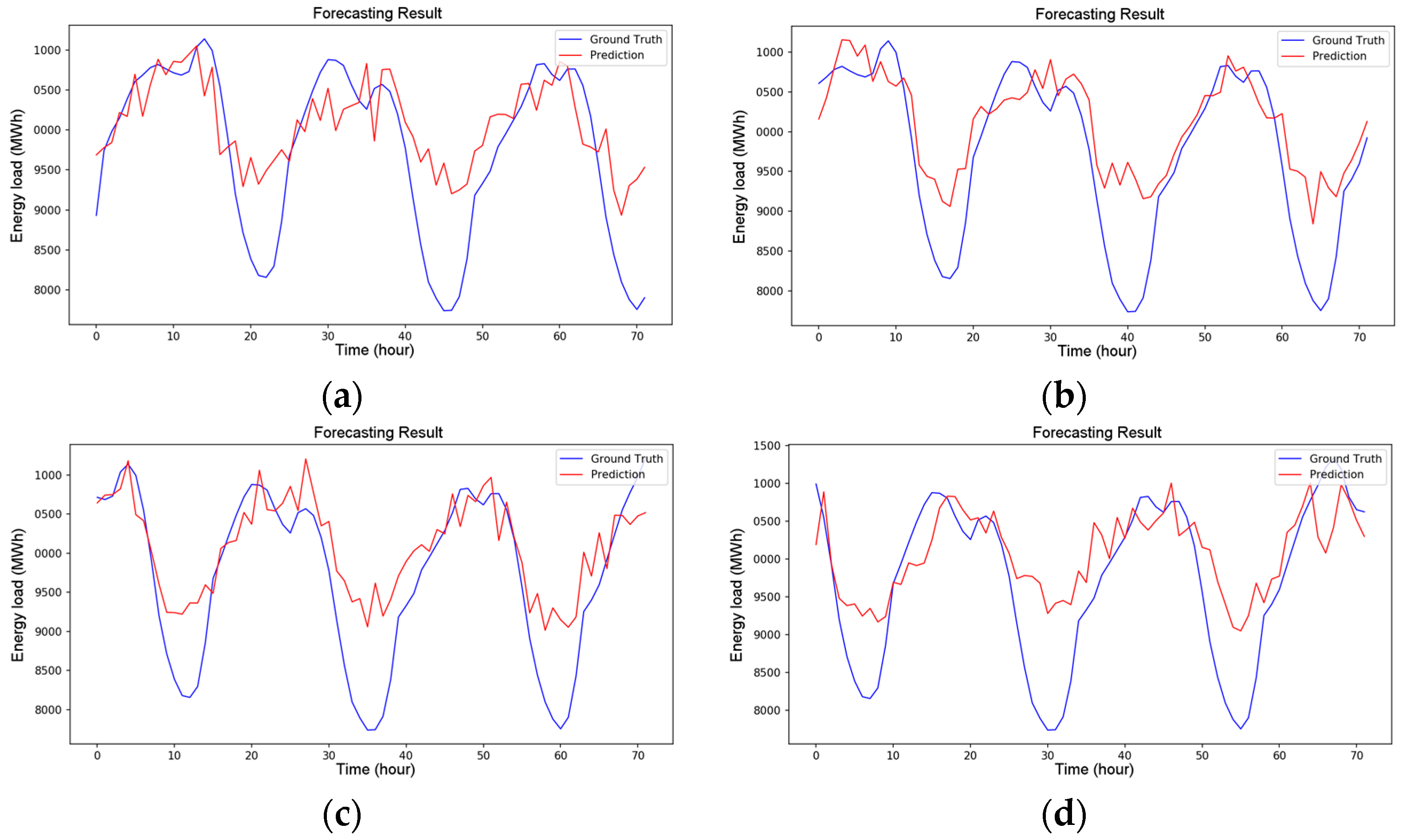




| Test | SVM | RF | DT | MLP | LSTM | DeepEnergy |
|---|---|---|---|---|---|---|
| #1 | 7.327408 | 7.639133 | 8.46043 | 9.164315 | 10.40804813 | 7.226127 |
| #2 | 7.550818 | 8.196129 | 10.23476 | 11.14954 | 9.970662683 | 8.244051 |
| #3 | 13.07929 | 10.11102 | 12.14039 | 19.99848 | 14.85568499 | 11.00656 |
| #4 | 16.15765 | 17.27957 | 19.86511 | 22.45493 | 12.83487893 | 12.17574 |
| #5 | 5.183255 | 6.570061 | 8.50582 | 15.01856 | 5.479091542 | 5.41808 |
| #6 | 10.33686 | 9.944028 | 11.11948 | 10.94331 | 11.7681534 | 9.070998 |
| #7 | 8.934657 | 6.698508 | 8.634132 | 7.722149 | 7.583802292 | 9.275215 |
| #8 | 18.5432 | 16.09926 | 17.17215 | 16.93843 | 15.6574951 | 13.2776 |
| #9 | 49.97551 | 17.9049 | 21.29354 | 29.06767 | 16.31443679 | 11.18214 |
| #10 | 11.20804 | 8.221766 | 10.68665 | 12.20551 | 8.390061493 | 10.80571 |
| Average | 14.82967 | 10.86644 | 12.81125 | 15.46629 | 11.32623153 | 9.768222 |
| Test | SVM | RF | DT | MLP | LSTM | DeepEnergy |
|---|---|---|---|---|---|---|
| #1 | 9.058992 | 9.423908 | 10.57686 | 10.65546 | 12.16246177 | 8.948922 |
| #2 | 10.14701 | 10.63412 | 12.99834 | 13.91199 | 12.19377007 | 10.46165 |
| #3 | 17.02552 | 12.42314 | 14.58249 | 23.2753 | 16.9291218 | 13.30116 |
| #4 | 21.22162 | 21.1038 | 24.48298 | 23.63544 | 14.13596516 | 14.63439 |
| #5 | 6.690527 | 7.942747 | 10.10017 | 15.44461 | 6.334195125 | 6.653999 |
| #6 | 11.88856 | 11.6989 | 13.39033 | 12.20149 | 12.96057349 | 10.74021 |
| #7 | 10.77881 | 7.871596 | 10.35254 | 8.716806 | 8.681353107 | 10.85454 |
| #8 | 19.49707 | 17.09079 | 18.95726 | 17.73124 | 16.55737557 | 14.51027 |
| #9 | 54.58171 | 19.91185 | 24.84425 | 29.37466 | 17.66342548 | 13.01906 |
| #10 | 13.80167 | 10.15117 | 13.06351 | 13.39278 | 10.20235927 | 13.47003 |
| Average | 17.46915 | 12.8252 | 15.33487 | 16.83398 | 12.78206008 | 11.65942 |
© 2018 by the authors. Licensee MDPI, Basel, Switzerland. This article is an open access article distributed under the terms and conditions of the Creative Commons Attribution (CC BY) license (http://creativecommons.org/licenses/by/4.0/).
Share and Cite
Kuo, P.-H.; Huang, C.-J. A High Precision Artificial Neural Networks Model for Short-Term Energy Load Forecasting. Energies 2018, 11, 213. https://doi.org/10.3390/en11010213
Kuo P-H, Huang C-J. A High Precision Artificial Neural Networks Model for Short-Term Energy Load Forecasting. Energies. 2018; 11(1):213. https://doi.org/10.3390/en11010213
Chicago/Turabian StyleKuo, Ping-Huan, and Chiou-Jye Huang. 2018. "A High Precision Artificial Neural Networks Model for Short-Term Energy Load Forecasting" Energies 11, no. 1: 213. https://doi.org/10.3390/en11010213
APA StyleKuo, P.-H., & Huang, C.-J. (2018). A High Precision Artificial Neural Networks Model for Short-Term Energy Load Forecasting. Energies, 11(1), 213. https://doi.org/10.3390/en11010213






